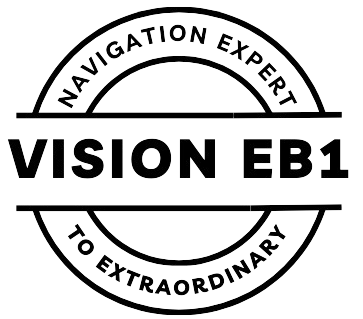If you’re an entrepreneur, a research scholar, a doctorate holder, a patent holder, or someone with recognized extraordinary abilities in your field, you’ve likely considered taking your talents to the United States. The U.S. is a hub for innovation, research, and business development, making it the ideal environment to further your career and expand your opportunities.
But the typical visa process can be long and complex, especially for those outside the U.S. who are unfamiliar with navigating the American immigration system. Many highly accomplished professionals are hesitant to apply for a U.S. visa because they believe the process is designed only for Nobel Prize winners or globally famous figures. However, if you have significant achievements in your field and a strong portfolio of work, the EB1A – Extraordinary Ability category could be your direct pathway to permanent residency in the United States.
The Unique Value of the EB1A Category
The EB1A is an employment-based, first-preference green card category reserved for individuals with extraordinary abilities. Unlike other employment-based visa options, the EB1A allows applicants to self-petition, meaning you do not need a U.S. employer to sponsor your application. This freedom opens up possibilities for entrepreneurs looking to start their own ventures, researchers seeking independent projects, or top talents wanting to explore opportunities without restrictions.
The best part? You can qualify for the EB1A without necessarily having a long list of publications, a PhD, or years of experience.
What Are the Key Requirements for EB1A?
The United States Citizenship and Immigration Services (USCIS) outlines the EB1A requirements in detail. To qualify, you must demonstrate extraordinary ability in your field, supported by evidence that shows your impact and achievements. Specifically, you need to meet at least three of the ten criteria set by USCIS or provide proof of a one-time achievement like a major, internationally recognized award.
The 10 Criteria for EB1A Include:
- Evidence of receipt of lesser nationally or internationally recognized prizes or awards for excellence.
- Membership in associations in your field which demand outstanding achievement of their members.
- Published material about you in professional or major trade publications or other major media.
- Participation as a judge of the work of others, either individually or on a panel.
- Original scientific, scholarly, artistic, athletic, or business-related contributions of major significance to the field.
- Authorship of scholarly articles in professional or major trade publications or other major media.
- Artistic exhibitions or showcases.
- Performance of a leading or critical role in distinguished organizations.
- High salary or other significantly high remuneration in relation to others in the field.
- Commercial successes in the performing arts.
Understanding the Path to Qualify
If you’re looking to apply for the EB1A from outside the U.S., it’s essential to first analyze your achievements against these criteria. For example:
- Entrepreneurs: Do you have a track record of building successful companies? Have your business innovations received media attention or led to industry-wide changes?
- Researchers and Scholars: Have your studies been cited by others, or have you presented your findings at international conferences? Do you play a leadership role in academic associations?
- Patent Holders: Have your patents led to significant advancements in your industry, or have they been implemented on a large scale?
- Performers and Artists: Have you performed at renowned venues or had your work exhibited in prestigious galleries?
Breaking Down the Requirements for You
Meeting the EB1A requirements isn’t just about checking boxes. It’s about building a narrative that shows why your accomplishments set you apart from others in your field. Here’s how to approach the process:
- Evaluate Your Evidence
Begin by reviewing your achievements and seeing how they align with the 10 criteria. Do you have awards, media recognition, or evidence of original contributions? If yes, identify which areas are the strongest. - Fill the Gaps
If you find gaps in your profile, consider ways to strengthen your case. For instance, if you lack media mentions, seek opportunities to have your work highlighted in reputable industry publications. If you haven’t judged the work of others, look for opportunities to serve on panels or review boards. - Build a Cohesive Application
Your EB1A petition should tell a compelling story about your journey and impact. Each piece of evidence should connect to an overarching narrative that clearly demonstrates your extraordinary ability.
Overcoming Misconceptions: EB1A is Not Just for Nobel Prize Winners
It’s a common myth that only those with worldwide fame or elite academic qualifications can apply for the EB1A. In reality, many successful applicants come from varied backgrounds, including entrepreneurs, independent researchers, and even top-level professionals who have gained recognition within their local or national industries.
You don’t need a string of international patents or a doctorate from a top university. What you need is proof of your sustained contribution and the ability to demonstrate that you’ve made a significant impact in your field.
Why Consider EB1A from Outside the U.S.?
- Start Planning Early: Applying for the EB1A from outside the U.S. allows you to strategically build your profile before moving. You can develop evidence of your achievements, enhance your professional presence, and align your application to meet USCIS expectations.
- Quicker Path to Permanent Residency: Unlike the H1B or other visa categories, EB1A is a direct path to a green card, meaning you could start your journey as a permanent resident rather than a temporary worker.
- Flexibility and Freedom: Once approved, you are not tied to any employer or specific job role. You can explore various professional opportunities or even set up your own business.
Connect with Vision EB1 to Explore Your Options
At Vision EB1, we specialize in guiding international talents through the complexities of the EB1A application process. Whether you’re an entrepreneur looking to expand your business in the U.S., a researcher ready to lead groundbreaking studies, or a patent holder aiming to commercialize your inventions, we can help you understand how your profile aligns with EB1A requirements.





